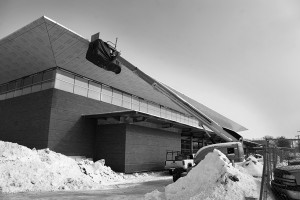
“We are very fortunate in that we’ve done enough recent building that we have a very experienced group of people on campus in facilities management,” said Vice President for Institutional Planning Marci Sortor.
Enough of the exterior work of both the Natatorium and the field house was completed that the builders could seal them off and continue working inside when the bad weather set in.
“So I’m not surprised that we’re doing well. I really had a lot of confidence, going into the project, in our team,” said Sortor.
Phase II includes a Natatorium and a field house. The Natatorium will house a 50-meter pool, which can simultaneously accommodate diving practice, the swim team, and wellness courses, team and community locker rooms, a multi-purpose dance studio and a climbing wall. The field house will hold an National Collegiate Athletic Association (NCAA) regulation track, tennis courts and the Physical Education faculty offices.
“When finished we’ll have some of the finest facilities, not only for athletics, but also for recreation and sports in general, as far as the country is concerned,” Director of Athletics Greg Wallace said.
Phase II is the final step in the 2000 Campus Plan to expand and improve the college’s facilities. It was to cost $72 million, and is currently running under-budget. When budgetary constraints brought up liquidity concerns with the project, the college floated a bond to meet costs.
The Athletics Center will open in August, ready for use next semester. It will more comprehensively meet the needs of Grinnell athletics than the current facility, the Physical Education Complex (PEC), which has recently been having structural difficulties—a roof support beam in the south part of the building cracked, necessitating its immediate repair. After the opening of the new center, the PEC will no longer be in use.
“The PEC will be boarded up until sometime in the future when it will be torn down,” said Associate Professor of Physical Education SFS Dee Fairchild.
Phase II will be the last major construction project until the effects of the recession are past, and the college has paid off the debts incurred by the bond. Future projects, such as the wind turbines, will be put off until the College’s capital reserve is sufficiently recovered.






























































